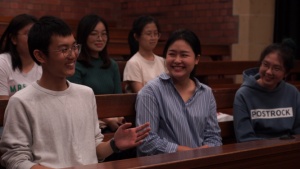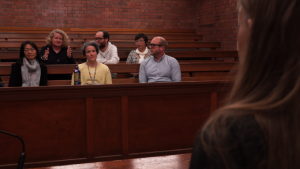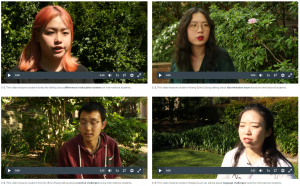As Adam Bridgeman reminds us, “starting university is a daunting and life-defining moment”. This is especially so if you move to a new city to undertake your university studies, and even more so if you come from another country. Add to that the challenges of learning a new culture and studying in a different language; it’s akin to climbing Mount Everest or completing an ultra-marathon!
A 2019 University of Sydney Strategic Education Grant provided me with the opportunity to partner with students from the Faculty of Arts and Social Sciences (FASS) to produce two video series aimed at facilitating the transition into university for international students. Academics and students involved were from FASS, and the project focused on Chinese international students; however, the videos were designed with academics, domestic and international students from across the University in mind as the target audience.
The project’s objectives were to build relationships between international and domestic students and between academics and students, as well as to minimize misunderstandings held by domestic students and academics about international students.
What inspired the project?
The project was inspired by the findings of the 2017 International Student Taskforce commissioned by the University, and responded to four key recommendations of the Taskforce Report, Improving the International Student Experience: support academic success; improve learner engagement; build social connection through transition; provide professional learning and support for academic staff. Additional inspiration was provided by feedback from the FASS student community, by research into the international student community in the Australian context (see, for example, the work of Arkoudis, Dollinger, Baik and Patience, 2019) and into pedagogical partnerships with students (Cook-Sather, Bahti and Ntem’s how-to guide, 2019, is particularly insightful). The project aligned with the direction of the Faculty and the University’s current strategic plans, focusing particularly on the transition experience that is central to the Student Experience Strategy .
Who was involved?
The long-held notion that teachers have much to learn from their students is evidenced by the growth of scholarship in collaborative staff-student partnerships in the last decade. Our project began from this premise and was informed by Healey and Healey’s Advance HE Framework for enhancing student success: student engagement through partnership. Our vision was to collaborate with local and international undergraduate and postgraduate students, as well as with colleagues.
I led the project in my capacity as FASS Associate Dean, Student Life. The grant enabled the employment of Tina Matolov from the Department of Media and Communications (MECO) as project manager tasked with identifying domestic MECO students keen to partner with us, and overseeing the students’ camera and editing work. With the help of the FASS Student Affairs and Engagement team, I located Chinese international students whose personal experiences provided much of the material for the videos. I enlisted the support of FASS colleagues familiar with the Chinese education system or experienced in teaching Chinese international students. In all we recruited four domestic student leaders from MECO, five international student leaders from FASS and Engineering and one international MECO student as video anchor. Eight staff shared their experiences as did 10 international student volunteers.


How did we go about the project?
International students prepared a list of questions for the staff and student focus groups. Focus group participants were asked to identify challenges experienced by Chinese international students across five categories, which we borrowed from Smith and Khawaja’s 2011 research: language, educational, socio-cultural, practical and discrimination. Participants were then invited to suggest potential solutions to these challenges. The international student leaders transcribed the focus group data, which was then analysed by staff and student team members. Five international student leaders used the focus group data to create their own scripts for video series 1, summarizing the challenges and potential solutions according to Smith and Khawaja’s categories. Scripts for academic staff volunteers were then created for video series 2, using the focus group data. The video scripts for video series 2 were translated into Mandarin so that the videos could be subtitled in Mandarin. The videos were filmed by MECO student leaders under the guidance of the project manager, and the footage edited.
Videos of Chinese international student perspectives

Video series 1 (five videos) features the five international student leaders who summarise the challenges they and their classmates have experienced in the transition into the University of Sydney, and offer some practical solutions to teachers and domestic students in order to help them overcome these challenges. The target audience for this series is academics who teach Chinese international students and domestic students who study alongside them.
Video series 2 (four videos) features four academics who summarize the challenges Chinese international students experience in the transition into the University of Sydney, and offer some practical solutions to help newly-enrolled Chinese students prepare for their academic life. The target audience for this series is newly-enrolled Chinese international students. The videos are subtitled in Mandarin.
Learnings and insights
All participants reflected positively on their involvement in the partnership. International students were thrilled to have a voice and have their opinions taken seriously by academics; being paid highlighted their perceived value of their contributions. Participating in a year-long project facilitated a sense of achievement and an increased sense of belonging and connection to the University. Similarly, domestic MECO students appreciated the opportunity to be paid to contribute to a worthy project, practise their disciplinary craft and learn from each other and from the MECO project manager. My advice to colleagues wishing to embark on student-staff partnerships is to remain flexible; listen actively and encourage feedback.
How can the videos be used to support international students?
Both video series are located on the University’s Teaching Resources Hub Canvas site.
Video series 1 can be uploaded onto the Canvas sites of units whose cohorts include Chinese international students, for sharing and discussion with students and colleagues; each of the five videos is approximately three minutes long.
Video series 2 is suitable for use by University and Faculty services that support Chinese international students.






1 Comment